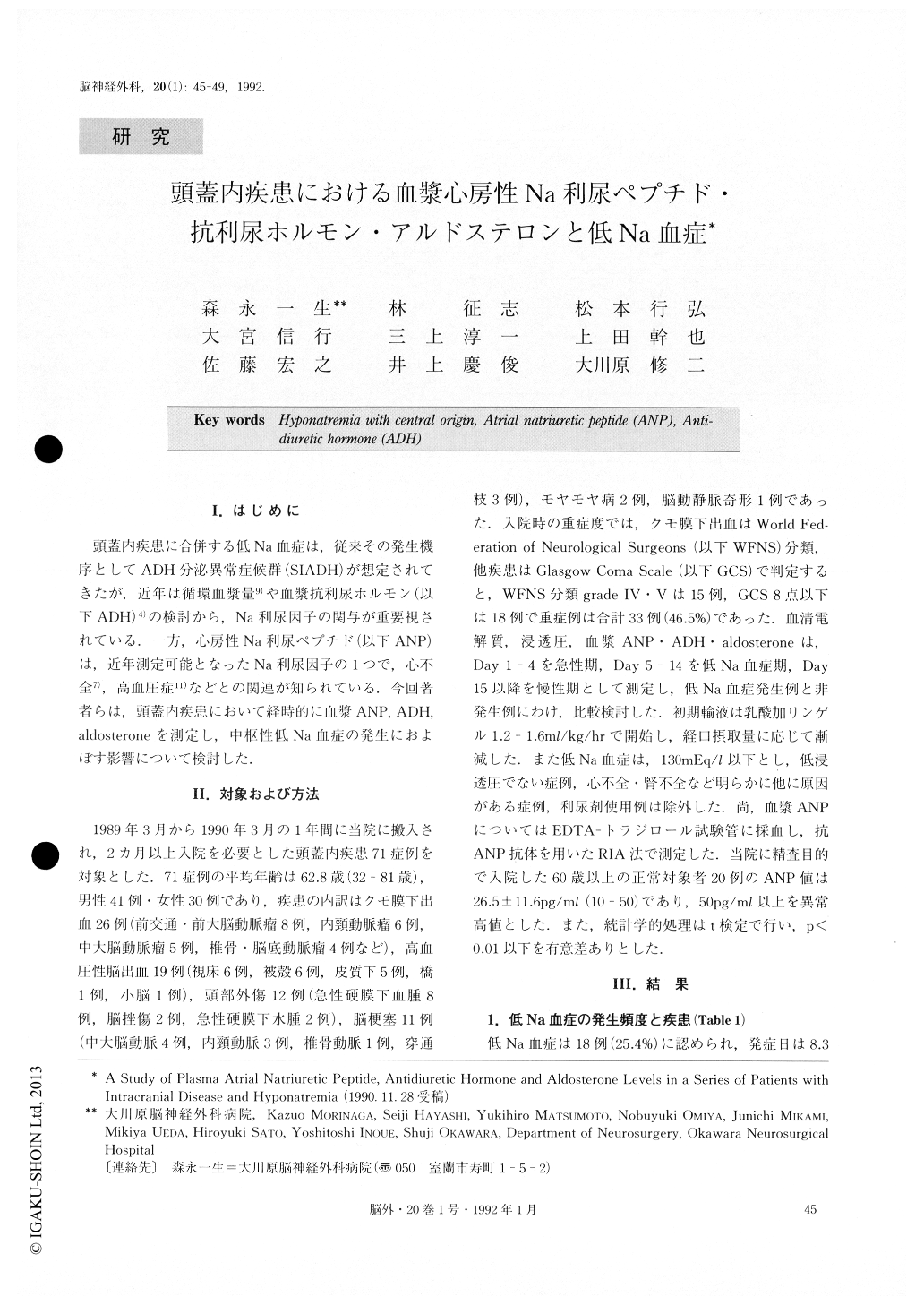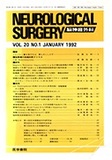Japanese
English
- 有料閲覧
- Abstract 文献概要
- 1ページ目 Look Inside
I.はじめに
頭蓋内疾患に合併する低Na血症は,従来その発生機序としてADH分泌異常症候群(SIADH)が想定されてきたが,近年は循環血漿量9)や血漿抗利尿ホルモン(以下ADH)4)の検討から,Na利尿因子の関与が重要視されている.一方,心房性Na利尿ペプチド(以下ANP)は,近年測定可能となったNa利尿因子の1つで,心不全7),高血圧症11)などとの関連が知られている.今回著者らは,頭蓋内疾患において経時的に血漿ANP,ADH,aldosteroneを測定し,中枢性低Na血症の発生におよぼす影響について検討した.
For intracranial diseases, plasma atrial natriuretic peptide (ANP), antidiuretic hormone (ADH) and aldosterone were determined and their effects on the development of hyponatremia with central origin were studied. The subjects were 71 cases of intracranial dis-eases which were admitted to our hospital during a period of 1 year from March, 1989 to March, 1990. The diseases were broken down to subarachnoid hemor-rhage 26 cases, hypertensive intracerebral hemorrhage 19 cases, head injury 12 cases, cerebral infarction 11 cases and 3 other cases. Serum-urine electrolytes, plas-ma ANP and ADH were determined in the acute stage on Day 1 to 4, in the hyponatremia stage on Day 5 to 14 and in the chronic stage on Day 15 downward. Hyponatremia was defined as the serum sodium levelof 130mEq// or less. Cases evidently having other causes such as heart failure and renal insufficiency were excluded. In the normal control group of persons who were admitted to our hospital for a close checkup (n=0), plasma ANP was 26.5±11.6pg/ml (10-50); levels of 50pg/ml or more were regarded as abnormally high. 1) Hyponatremia was found in 18 cases (25.4%) , subarachnoid hemorrhage in 7 cases, hypertensive in-tracerebral hemorrhage in 4 cases, head injury in 5 cases and others in 2 cases. 2) The time of onset of hyponatremia was on the 8.3 hospital day. The dura-tion was 7.2 days. The minimum serum sodium level was 124.6mEqa 3) There was no significant change in the plasma aldosterone level at each stage. 4) The plas-ma ADH level was high in the acute stage regardless of whether or not hyponatremia developed, but tended to fall off gradually and was normalized in the hypona-tremia stage. 5) The plasma ANP level in cases of hypo-natremia was 42.3±20.9pg/ml in the acute stage, 42.9 ±26.1pg/ml in the hyponatremia stage and 25.6± 21.1pg/ml in the chronic stage, there being a tendency for the level in the acute stage to continue into the hyponatremia stage. By contrast, the plasma ANP level in non-hyponatremic cases was significantly low in the hyponatremia stage compared with the acute stage, with 58.9±18.1pg/ml in the acute stage and 35.7± 20.2pg/ml in the hyponatremia stage (p<0.005). Pre-dicting development of hyponatremia from plasma ADH and ANP levels in the acute stage is difficult. In-adequate secretion of ANP rather than ADH appeared to be an important factor for the development of hypo-natremia, but the plasma ANP level was not always abnormally high, so involvement of other sodium diure-tic factors should also be kept in mind.

Copyright © 1992, Igaku-Shoin Ltd. All rights reserved.


